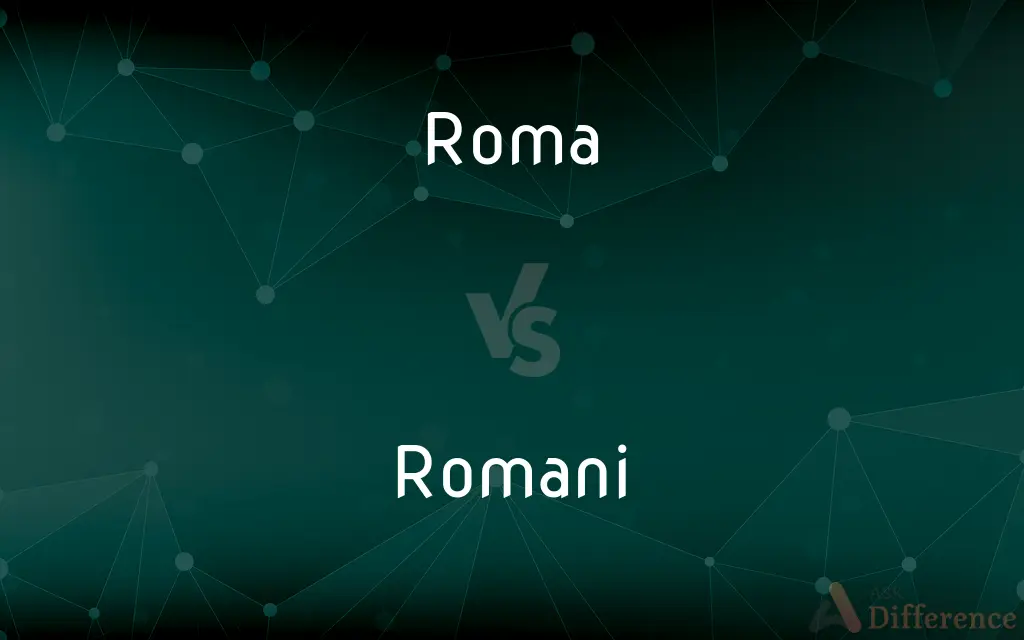Roma vs. Romani — What's the Difference?
By Fiza Rafique & Maham Liaqat — Updated on April 19, 2024
Roma often refers to the ethnic group commonly known as Gypsies, while Romani is the language spoken by the Roma people.

Difference Between Roma and Romani
Table of Contents
ADVERTISEMENT
Key Differences
Roma is primarily used to denote an ethnic group originating from the Indian subcontinent, who migrated to Europe around a thousand years ago. Whereas Romani refers to their language, which includes multiple dialects and has influences from European languages.
Roma people have a diverse culture that is known for its rich oral traditions and vibrant music. On the other hand, Romani language is central to preserving this cultural identity, enabling communication and cultural continuity among Roma communities spread across different countries.
Roma communities are often recognized for their nomadic or semi-nomadic lifestyle, which has been a significant aspect of their identity in various European countries. While Romani is not just a means of communication but also a marker of ethnic identity, distinguishing them from other population groups.
Roma face significant social challenges including discrimination and marginalization in many of the countries they inhabit. Whereas Romani language itself is often underrepresented and at risk of dying out, lacking official recognition in many regions.
Roma as an ethnic term does not solely refer to a language or a nationality but encapsulates a broader ethnic and cultural identity. In contrast, Romani strictly describes the language, embodying the linguistic heritage and complexities of the Roma people.
ADVERTISEMENT
Comparison Chart
Definition
An ethnic group
A language
Primary Usage
Refers to people
Refers to language
Geographic Spread
Widespread across Europe
Spoken wherever Roma live
Cultural Significance
Represents a diverse culture
Key to preserving Roma identity
Risk of Marginalization
High, as a social group
High, as a language
Compare with Definitions
Roma
An ethnic group known for their nomadic traditions.
The Roma have traveled across Europe for centuries.
Romani
Lacks official status in many countries.
Romani is not officially recognized in most European nations.
Roma
Faces issues like social exclusion and discrimination.
Roma communities frequently face housing challenges.
Romani
Spoken in various dialects across Europe.
Vlax and Sinti are two main Romani dialects.
Roma
A group often misunderstood and stereotyped in media.
Films often portray Roma with cliched roles.
Romani
A language with roots in Northern India.
Romani vocabulary contains words from Sanskrit.
Roma
Identified not by a nation-state but by common ethnic traits.
The Roma share a distinct cultural heritage.
Romani
Essential for maintaining Roma cultural identity.
Romani language classes help young Roma connect with their heritage.
Roma
Recognized for their contributions to music and dance.
Roma musicians have influenced flamenco.
Romani
At risk of extinction due to assimilation pressures.
Many Romani speakers are shifting to dominant national languages.
Roma
Italian name for Rome
Romani
A member of a people that arrived in Europe in migrations from northern India around the 14th century, now also living in the Americas and Australia. Many Romani groups have preserved elements of their traditional culture, including an itinerant existence and the Romani language. Also called Roma.
Roma
A member of a subgroup of the Romani people, primarily inhabiting Central and Eastern Europe with smaller populations in other regions.
Romani
The Indic language of the Romani.
Roma
See Romani.
Romani
Of or relating to the Romani or their language or culture.
Roma
Alternative case form of Roma.
Romani
Of or relating to the Gypsies or their language or culture;
Romani nomads
Romany folk songs
A Gypsy fortune-teller
Roma
A member of a nomadic people originating in northern India and now living on all continents
Roma
Capital and largest city of Italy; on the Tiber; seat of the Roman Catholic Church; formerly the capital of the Roman Republic and the Roman Empire
Common Curiosities
How many people speak Romani worldwide?
It's estimated that Romani is spoken by between two to five million people, mainly in Europe but also in the Americas and parts of the Middle East.
Can someone who is not Roma learn the Romani language?
Yes, non-Roma can learn Romani, much like any other language, though learning opportunities might be limited due to the language's marginalized status.
What are the main dialects of Romani?
Major dialects of Romani include Vlax, Balkan, and Sinti, each with distinct linguistic features and geographic distributions.
What are the key challenges in documenting the Romani language?
Challenges include its status as a primarily oral language, dialectal variation, and the lack of standardized orthography.
What distinguishes the Roma from other ethnic groups in Europe?
The Roma are distinguished by their unique cultural practices, language, and historical experience of migration and marginalization.
Why is Romani considered an important language for the Roma?
Romani serves as a crucial element of cultural identity and cohesion among the Roma, connecting disparate communities through a common linguistic heritage.
How has Roma culture influenced mainstream society?
Roma culture has influenced mainstream music, dance, and arts, particularly noted in the popularity of styles like flamenco and jazz manouche.
What are some common misconceptions about the Roma?
Common misconceptions include stereotypes of Roma as nomads or fortune tellers, which do not accurately reflect the diverse lifestyles and professions of Roma today.
What are the educational opportunities for Roma children?
Educational opportunities for Roma children vary, with ongoing challenges related to access and equality; however, there are increasing initiatives aimed at improving education through scholarships, mentoring, and inclusive policies.
How do Roma preserve their culture?
Roma preserve their culture through oral traditions, music, dance, storytelling, and increasingly through formal cultural preservation initiatives.
What role do Roma organizations play in society?
Roma organizations advocate for rights, provide educational and cultural programs, and work to combat discrimination and promote social inclusion.
Is there a political representation for Roma in Europe?
Yes, there are Roma representatives and activists at various levels of governance in Europe, aiming to influence policies affecting the Roma community.
How do Roma ceremonies and traditions differ across countries?
Roma ceremonies and traditions vary widely, influenced by the local cultures of the countries where they live, yet many share common elements like music and dance.
How is Romani typically written?
Romani is written using the Latin alphabet, though it also incorporates characters from other alphabets depending on the country and dialect.
What efforts are being made to officially recognize Romani in countries where Roma live?
Efforts include advocacy for bilingual education, inclusion in public broadcasting, and recognition of Romani in national frameworks for minority languages.
Share Your Discovery

Previous Comparison
Extraordinary vs. Remarkable
Next Comparison
Skin vs. HideAuthor Spotlight
Written by
Fiza RafiqueFiza Rafique is a skilled content writer at AskDifference.com, where she meticulously refines and enhances written pieces. Drawing from her vast editorial expertise, Fiza ensures clarity, accuracy, and precision in every article. Passionate about language, she continually seeks to elevate the quality of content for readers worldwide.
Co-written by
Maham Liaqat














































